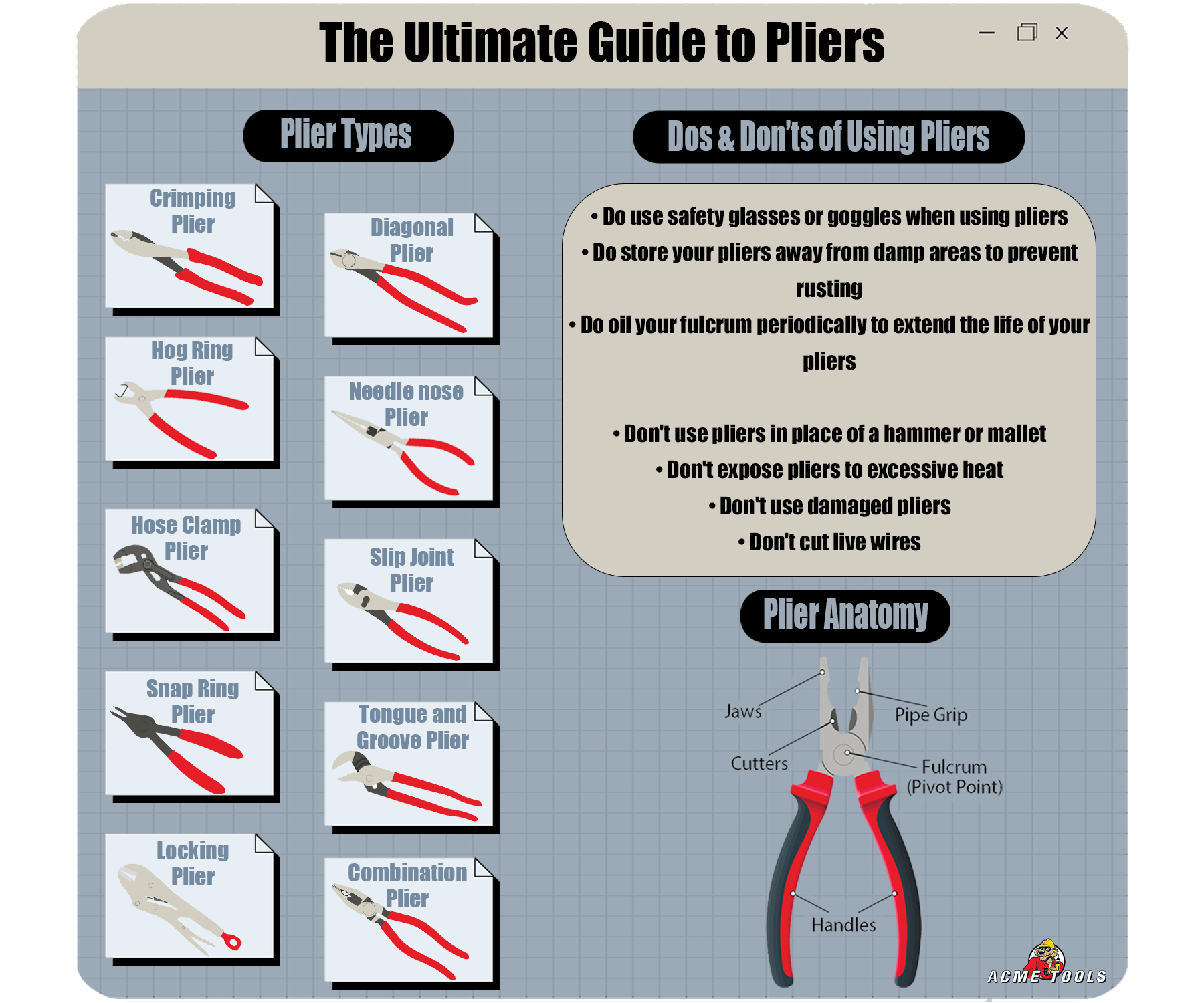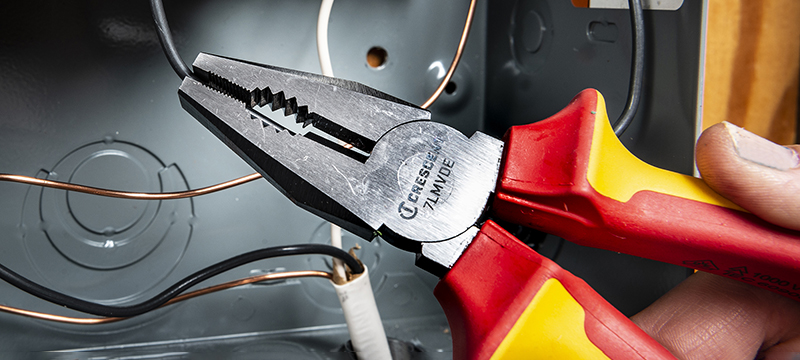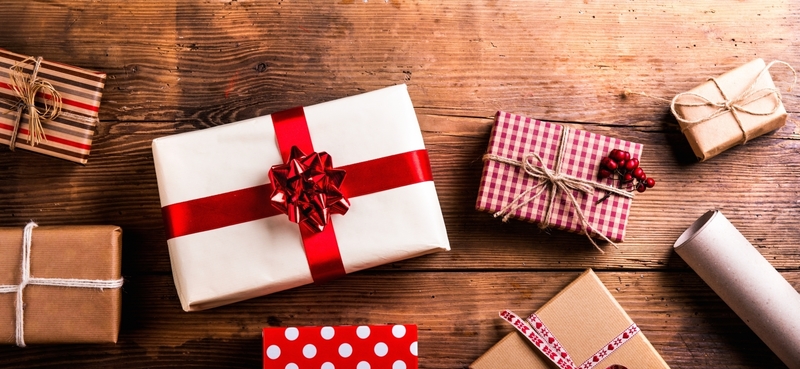For DIYers and professionals alike, pliers are a versatile, must-have tool for any toolbox.
Over time, pliers have become designed for specific trades such as electrical, plumbing, HVAC, and more. Whether you’re new to the do-it-yourself lifestyle, or you just want to learn more, lets dive into some crucial plier information.

Plier Anatomy
It’s necessary to understand pliers’ working parts and their duty during use.
Jaws: Plier jaws come in a variety of patterns and designs. The tip of the jaw, known as the nose, can be round, flat, or half-round. Functionalities of the plier jaws can include gripping, bending, and holding objects.
Cutters: Cutters’ intended use is for cutting bolts, wires, nails, and other materials.
Fulcrum (Pivot Point): The fulcrum holds the jaws and handles together, creating leverage and cutting power for the pliers.
Handles: The handles are usually covered by a molded material that helps with grip. There are also insulated handles that help prevent electrical shock.
Pipe Grip: The round, serrated portion of the jaws is called the pipe grip and is ideal for tightening and releasing pipe joins and rounded nuts.
Kinds
Combination: Combination pliers implement two of the most common uses: cutting and gripping. They are generally used for twisting, bending, and stripping. Combination pliers have a serrated square jaw and are equipped with cutters and a pipe grip.
Combination pliers are commonly called linesman pliers; however, linesman pliers are typically longer than combination pliers to increase leverage, which is necessary for electrical workers.
Recommended: Milwaukee 7in1 High-Leverage Combination Pliers
Slip Joint: Slip joint pliers feature an adjustable fulcrum that allows the jaws, including the pipe grip, to open wider and accommodate the gripped object. Slip joint pliers are mainly used for holding and bending but can also be used for loosening and tightening nuts and bolts.
Recommended: Stanley 6 In. Slip Joint Pliers
Tongue and Groove: Tongue and groove pliers have a vast jaw capacity that offers an extensive range of motion for gripping and turning pipes, fasteners, fittings, and more. These pliers can also go by multi-grips, groove joints, or water pump pliers.
Recommended: Crescent Tongue and Groove Pliers 4-1/2″ Mini V-Jaw Dipped Handle
Hog Ring: Hog ring pliers clamp hog rings, metal rings with a split center, together quickly and efficiently. Hog rings are used in upholstery, automotive, gardening, and outdoor use. Hog ring pliers are a popular jewelry plier as bracelets and necklaces are sometimes made using hog rings.
Recommended: Spec Ops M7 Auto Feed Hog Ring Plier
Hose Clamp: Hose clamp pliers are equipped with jaws designed to grip soft hoses to stop the fluid from flowing so the user can work without spillage. They’re also used to remove and replace hose clamps.
Recommended: Knipex Spring Hose Clamp Pliers with Retainer 250 mm
Locking: Locking pliers are created to grip an object without assistance from the human hand. Locking pliers, also called vise grips, use an adjustable dial to lock them in place, allowing them to hold the object independently from the user.
Recommended: Irwin 10 In. Straight Jaw Locking Pliers
Needle Nose: Needle nose pliers have long, tapered jaws ideal for use in hard-to-reach areas.
These pliers have similar functions to those of combination pliers. Needle nose pliers, or long nose pliers, are great for bending, holding, placing, and cutting. They have a straight nose or bent nose that has an angle between 45° and 90°. These also make great jewelry pliers, making bending thin wire and placing small objects easy.
Recommended: Klein Tools 5″ Needle-Nose Pliers
Diagonal: Diagonal pliers usually have a diagonally angled, bladed jaw and longer handles that allow them to cut through steel and copper wires. Diagonal pliers, also called cutter pliers, should never be used to cut through objects thicker than the pliers’ ability or to cut live wire.
Recommended: DEWALT 10 In. Diagonal Pliers with Prying Tip
Snap Ring: Snap ring pliers were explicitly invented to make placing snap rings easier. A snap ring is a small metal ring set in a bearing. Typically used in household appliances, vehicles, and generators, the snap ring is installed in parts like grooves and shafts.
Snap ring pliers, regularly known as circlip pliers, come in internal and external. Internal clip pliers’ noses close, and the ring is attached to the narrow tip. External clip pliers widen the snap ring, and the handle is gripped.
Recommended: Gearwrench Fixed Tip Convertible Snap Ring Pliers
Crimping: Crimping pliers, often called crimpers or wire crimpers, are crimping tools designed to crimp wires or small metal objects, creating a firm closure or hold. While these are usually used by professionals who work closely with wire, they’re also fantastic jewelry pliers for crimping beads and closing wire or string ends to keep necklaces and bracelets from unraveling.
Recommended: Channellock 8.25 in Crimping Pliers
Dos and Don’ts of Using Pliers
- Do use safety glasses or goggles when using pliers
- Do store your pliers away from damp areas to prevent rusting
- Do oil your fulcrum periodically to extend the life of your pliers

- Don’t use pliers in place of a hammer or mallet
- Don’t expose pliers to excessive heat
- Don’t use damaged pliers
- Don’t cut live wires

Shop pliers and more at Acme Tools.





3 Comments
combination pliers
January 15, 2025 at 4:21 amA well-written blog! I’d love to see a comparison of combination pliers with other types of pliers in future posts.
Acme Tools
January 15, 2025 at 9:04 amThank you for the suggestion. We will look into this and see what we can come up with.
De Neers Tools
March 26, 2025 at 4:27 pmGreat breakdown of combination pliers! The versatility of these tools is impressive. Do you have any recommendations for the best brands?